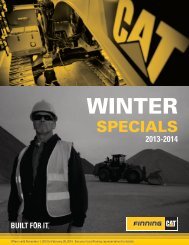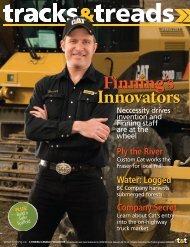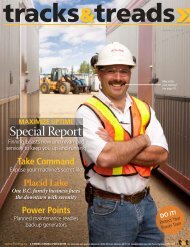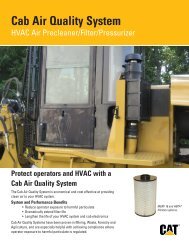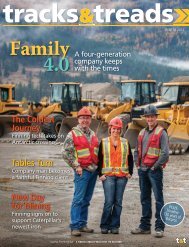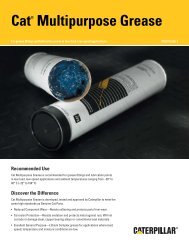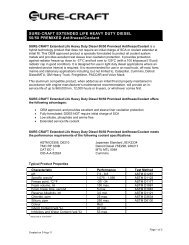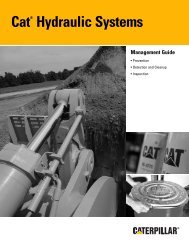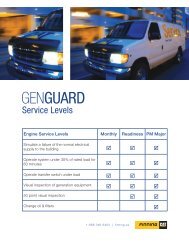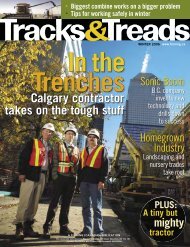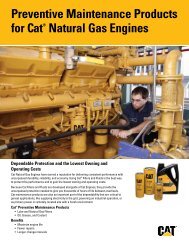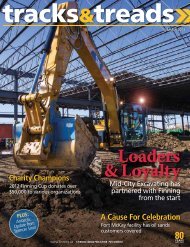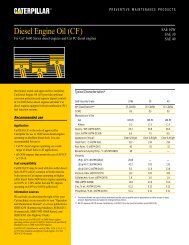INANCING - Finning Canada
INANCING - Finning Canada
INANCING - Finning Canada
- No tags were found...
You also want an ePaper? Increase the reach of your titles
YUMPU automatically turns print PDFs into web optimized ePapers that Google loves.
Caterpillar is offering special financing on the followingmachines until May 31, 2012.• Compact Track Loaders• Multi Terrain Loaders• Skid Steer Loaders• Compact Wheel Loaders• Mini Hydraulic Excavators• Backhoe Loaders• Small Hydraulic Excavators• Small Track-Type Tractors• Small Wheel LoadersDon’t miss this limited time opportunity! Contact your <strong>Finning</strong> representative today for more details.1-888-finning | finning.ca(346-6464)*Offer good from February 1, 2012 to May 31, 2012 on select new models at participating Cat Dealers. Offer is available tocustomers in the USA and <strong>Canada</strong> only and cannot be combined with any other offers. Financing and published rate are subjectto credit approval through Cat Financial. Subject to machine availability. Offer may change without prior notice and additionalterms may apply.©2011 Caterpillar All rights reserved. CAT, CATERPILLAR, their respective logos, “Caterpillar Yellow,” the “Power Edge” trade dressas well as corporate and product identity used herein, are trademarks of Caterpillar and may not be used without permission.
BY JEN JANZENEDITOR-IN-CHIEFA ModelCraftsmanPrecision and patience are at the heart of this ironaficionado’s effortsMany model builders use draftingsoftware to create blueprints,but Gabriele planned his machinemodel with manual drawings.When Gabriele Banci posted photos of his D11on an online forum for radio-controlled model buildingenthusiasts, he only wanted to share his projectwith fellow hobbyists. He never expected images ofhis work to make it into the pages of a magazine publishedon another continent.Early last year, we receivedphotos of a D11 track-typetractor model. We were appropriatelyimpressed, but with noreturn address on the envelopeand no additional informationincluded in the package, we couldn’t recognize thepristine craftsmanship. In short, we had a mystery onour hands.Tracks & Treads subscriber Martin Hicks swoopedin to solve it for us. He saw the pics in the summer2011 issue, along with our plea for information aboutthe anonymous builder. Martin recognized the picturesfrom an online radio-control model forum, andhe passed the builder’s information on to us.Gabriele, a retired banker living in Italy, and amember of an Italian club for heavy equipment modelenthusiasts, was happy to talk about his project.Turns out he produced hand-drawn plans (manymodel builders use drafting software to create plansfor such projects), using a 1:50 die cast model. Hestudied website photos and a D11 parts manual tofill in the blanks.Part of building a model like Gabriele’s is not onlygetting the parts to look right, but building a machinethat is realistic in every way, even down to the finemovements of its real-life muse. Four years afterstarting the project, the machine is operative, thoughGabriele says he still needs to finish and test thehydraulic system.What is most impressive about the mini D11 isthat Gabriele has never seen a full-size version inperson. “I chose this machine for its impressivenessand power,” he says. “But mostly for the mechanicalarchitecture.”His ultimate goal, once he’s perfected his ownmodel? To build more miniature D11s for fellowItalians who are as fascinated by Caterpillar equipmentas he is.For his help in solving our mystery builder riddle,Martin received a $50 Heavy Duty Gear Store certificate,and we sent some Cat goodies over the pond toGabriele too.SHARE THE LOVECheck out page 8 for another Cat model maker, this onea 15-year-old woodworker. If you share the love of yellowiron creation, whether it’s radio-control models or a cakethat looks like a scraper, send us a picture of your workand we’ll showcase it in a future issue.4 Spring 2012www.finning.ca
SPRING 2012 Volume 53, No. 2PUBLISHERRuth Kellyrkelly@venturepublishing.caEDITOR-IN-CHIEFJen Janzenjjanzen@finning.caASSOCIATE PUBLISHERJoyce Byrnejbyrne@venturepublishing.caEDITORMifi Purvismpurvis@venturepublishing.caCOPY CHIEFKim TannasEDITORIAL ADVISORSHilary Anaka, Heather Evens, Jeff Howard,Michelle Loewen, Jeff WuiteART DIRECTORCharles Burkecburke@venturepublishing.caASSOCIATE ART DIRECTORAndrea deBoerASSISTANT ART DIRECTORColin SpencePRODUCTION MANAGERVanlee RobbleePRODUCTION COORDINATORBetty-Lou SmithCIRCULATION COORDINATORJennifer Kingcirculation@venturepublishing.caADVERTISING REPRESENTATIVEAnita McGillisamcgillis@venturepublishing.caCONTRIBUTING WRITERSRobin Brunet, Caitlin Crawshaw, David DiCenzo, Keith Haddock,Michael Hingston, Cailynn Klingbeil, Michelle Lindstrom,Lindsey Norris, Tricia Radison, Lisa RicciottiCONTRIBUTING PHOTOGRAPHERS AND ILLUSTRATORSPhillip Chin, Rob Olson, Heff O'Reilly, Chip ZdarskyTracks & Treads is published to provide its readerswith relevant business, technology, productand service information in a livelyand engaging manner.Tracks & Treads is published for<strong>Finning</strong> <strong>Canada</strong> byVenture Publishing Inc.10259-105 StreetEdmonton, Alberta T5J 1E3Phone: 780-990-0839Fax: 780-425-4921Contents © 2012 by <strong>Finning</strong> <strong>Canada</strong>. No part of this publicationshould be reproduced without written permission.PM #40020055FAITHFUL READER: I was delightedwhen the Winter 2011 Tracks & Treadsarrived in the mail. I found the issue reallyinteresting. A note about the 289C compacttrack loader working on a mountainbike track: last summer for a week herein Quesnel, B.C., I helped build such afacility too. They had the same 289C.What a great tool!Last spring I made a comment on anaerial photo of a frac job done by CalFrac Well Services. I left the commentson the voicemail, and their retiring CEOphoned me to say my comments hadmade many people in their company very happy and hethanked me for them. While in Calgary last summer, I visited Cal Fracin Red Deer. I got out of the taxi and noticed their next-door neighbouris <strong>Finning</strong>.This January I was visiting with one of the guys I used to work with.He is now a grader operator and he was telling me they have a new Catgrader that he operates. It has no steering wheel or levers for the bladecontrol, just two joy sticks. When spring comes I’ll ride my bike out thereto have a look at it. Thanks again for Tracks & Treads.Forbes Campbell, Quesnel, B.C.SENIOR FAN: I was wondering if there was a possibility of gettingTracks & Treads. I have always admired those yellow machines. In the late1950s I worked for B&T Contractors at Leader, Alberta. They got a newD6 Cat and an overshot loader installed. I enjoyed working with thatmachine and I just loved the sound of the motor.In the early 1960s, I opened a pit just west of Leader, about 20 mileswest of Three Hills. I had a gravel crusher powered by a D7 motor, andI had a 920 Cat loader and later another 950 for feeding and loading.Now I am almost 88 years old and retired in Pincher Creek, but wheneverI’m travelling and see a crushing outfit, I’m tempted to stop andask what kind of loader they have. I would really appreciate getting themagazine.Harvey Thiessen, Pincher Creek, AlbertaSure thing, Harvey. We’ll send you a quarterly subscription toTracks & Treads. Enjoy it!– EditorsTell us what you thinkTracks & Treads would love to hear from you. Tell us what you thinkof the magazine’s stories, columns and look, so that we can improveit and make it a more interesting read.Send your comments to editor-in-chief Jen Janzen by email atjjanzen@finning.ca or the old-fashioned way to: Jen Janzen, Tracks & Treads,<strong>Finning</strong> <strong>Canada</strong>, 16830 – 107 Avenue, Edmonton, Alberta T5P 4C3www.fi nning.cawww.finning.ca Spring 2012 5
BY MICHELLE LINDSTROM AND CAILYNN KLINGBEILAlmost RealIt’s Here!Learn to use a Caterpillar excavatorwithout having to go outside! Eightmodels of Cat simulators – medium offhighwaytruck, mining truck, M-seriesmotor grader, track-type tractor, hydraulicexcavator, small-wheel loader and largewheelloader – have updated graphics,exercises and training material availablefor customers to train employees beforesending them out into the field.The feedback so far from operators isthat the controls are very realistic, saysWes Rains, SITECH Western <strong>Canada</strong>Solutions Ltd. technology sales and servicerepresentative.The benefits of Cat simulators areplenty. Here are some of them:• Operators gain muscle memory onmachines before entering the realworld, thereby increasing safety.• Companies reduce costs for fuel andengine maintenance. The simulatorstake the training burden off machines,which can remain working on thejobsite.• Newbies can’t hurt simulators the waythey can machines, reducing potentialdamage and repair costs.• Instructors can train multiple studentsat the same time, any time of the day, inany weather.• Companies can test potential employeesand choose the most qualified operatorsbased on accurate Cat simulator results.• The first year of Cat simulator globaltech support (in English) is free withpurchase. Translation services areavailable for a fee.• Customers can use SimU Campusrecords management software on allCat simulator models. User resultsare easy to access and run on thesame computer as the simulatorsoftware. Instructors can customize thecurriculum, benchmarks and defaultmeasurements included in the trainingprogram to best fit their needs.• Pass/fail results are immediate.After months of waiting, the CT660, Cat’s first ever vocational truck,is here. <strong>Finning</strong> industry marketing manager Duncan Schroff says the firsttruck will be ready for work in early March. The truck made an appearance ata <strong>Finning</strong> management meeting at the end of February, then went to workat The Cat Rental Store in Edmonton.Cat has always supplied engines and components for trucks, but never thewhole truck, which makes this new product especially exciting for Caterpillaraficionados. A customer has already signed an order for the truck andSchroff says excitement continues to build.After January’s World of Concrete Trade Show in Las Vegas, a customercalled wanting three trucks. “He had never seen them before and he sawthem in Las Vegas and was all excited and wanted to order them rightaway,” Schroff says. As the new trucks begin to hit the road, it is likely thosecalls will keep coming.PARTS ONLINECat machines in need of parts? Parts in need of a new tool?Parts repair in need of a little direction? parts.cat.com will give youall of that – any time, any day. Reference material, specs, pictures andvideos are all on this site to guide you to the right part or information yourequire to complete your job. Cat updates the site all the time with newinfo tidbits, so it’s worth visiting often. If, for some reason, you still can’tfind what you need on the site, contact your local <strong>Finning</strong> rep.6 Spring 2012 www.finning.ca
Pave and SaveCaterpillar Paving brought its Paver Saver program to a newlevel, explains Sheldon Allan, a <strong>Finning</strong> paving and compactionspecialist. The program, which launched last November, runsthrough to April 30, 2012.In general, the Paver Saver program offers North American Catcustomers great opportunities such as rebuilds, machine sales,over-the-counter equipment paving parts, general Cat parts andfinancing. The program looks a little different in each <strong>Finning</strong>location. For example, the program might offer free Cat bootsfor contractors who schedule an inspection, or discounts onparts for paving equipment.“Winter is the off-season for paving equipment,” saysAllan. “And it’s also rebuild time, so we want to work withour customers to help them prevent critical down timefor the 2012 paving season.”Time to Kid AroundIn February, the Red Deer Rebels teamedup with the local branch of <strong>Finning</strong> <strong>Canada</strong>(as presenting sponsor) for a KidSport charitybenefitting local children. During the first periodof a game in February, fans of the Rebels bid onjerseys the players were wearing. Bidding endedafter the first intermission. At the end of thegame, each Rebel’s player peeled off his jersey,autographed it and presented it to the luckyauction winner. Along with <strong>Finning</strong> <strong>Canada</strong>, theRebels presented a cheque to KidSport Red Deertotalling $26,250.KidSport aims to ensure that all children haveopportunities to play the sports they love. Thefunds will help support children, through grantsto help with the cost of registration fees and/orequipment, so they can achieve health and wellbeingthrough sport.www.finning.caSpring 20127
Devastated Demo Days by FireDid you know <strong>Finning</strong> offers a full lineof Caterpillar work tools and attachments?The heavy-duty tools tailor Cat machines to acustomer’s requirements and working needs,offering a comprehensive assortment ofhydro-mechanical and fabricated tools. Catbrandedwork tools are specifically designedfor Caterpillar equipment,resulting in maximumdurability, performance andfuel efficiency.Colin Yanitski, <strong>Finning</strong>’sproduct manager incharge of work tools, is inthe process of planningdemos for certain worktools and attachments in2012. “We have exceptionalwork tool attachments,” Yanitskisays. He is making it a priorityto educate customers on thebenefits of using them.WHEELS STILL TURNINGThere’s good news for the folks on yournext jobsite: <strong>Finning</strong> is extending its H-Serieswheel loader promotion. And for customers ingeneral construction, <strong>Finning</strong> is also extendingthe sweet deal of zero-per-cent financing for42 months.If you’ve been thinking about a wheel loader,now’s the time. Eligible models include the950H, 962H, 966H, 972H, 980H and IT62H.Move more tons per litre with the H-Seriesand its performance series buckets, powershifttransmissions, variable shift control and constantnet HP. These are just some of the componentsproviding best-in-class performance.The techs love the H-Series. Ground-levelservice points, electrical and hydraulic servicecentres, remote pressure taps and easy enginecompartment access make maintenance a breeze.Ask your <strong>Finning</strong> rep about financing andcapitalize on <strong>Finning</strong>’s free extended powertrainand hydraulic warranty and some great options:parts credit, rental credit, additional Cat work toolsand preventive maintenance contracts.8 Spring 2012 www.finning.ca
TRUE BRAND LOYALTYMatt Haasen, president of Blue Con Excavating in Calgary, recently sent theseimages of a model Cat excavator that his 15-year-old son Ryan made to <strong>Finning</strong>rep Trevor Wiebe. By the looks of things, Haasen would do well to keep the boyclose – he’d make a good <strong>Finning</strong> tech one day.Another reader sent us a link that the Haasens might enjoy. It has pictures of craftmodel Cats in progress, specifically, the D11 model we ran a couple of issues back.You’ll also find a tiny D9R and 463 scraper. Check it out, Ryan:www.rctruckandconstruction.com/showthread.php?t=310.BUCYRUS UPDATECaterpillar, new owners of mining equipment company Bucyrus, recentlyannounced that <strong>Finning</strong> will acquire the distribution and support end of thebusiness in Western <strong>Canada</strong> and portions of South America and the U.K.<strong>Finning</strong> will provide sales, service and support for former Bucyrus miningproducts in all of <strong>Finning</strong>'s dealership territories. The transaction is valued atapproximately USD $465 million.“The acquisition of the Bucyrus distribution business is a major strategicmilestone for <strong>Finning</strong> that will expand our leadership position in the growingmining sector and deliver greater value for our customers and shareholders,”said Mike Waites, president and CEO of <strong>Finning</strong> International, in a press release.“On the close of this acquisition, <strong>Finning</strong> will be able to sell and support acomprehensive product line that meets our customers’ surface and undergroundmining equipment needs.”This sale makes <strong>Finning</strong> an expert in an industry-leading product platform.Cat mining equipment can now be found in every part of a mining operation, inresource-rich mining territories in South America and <strong>Canada</strong>. The move bringsnew opportunities and robust, long-term growth potential for <strong>Finning</strong> and thecustomers it serves.“We’re making good progress as we transition the product distribution andsupport of former Bucyrus machinery to Cat dealersaround the world,” said Steve Wunning, Caterpillargroup president with responsibility for resourceindustries. “Cat dealers have a proven track recordhelping customers realize the highest productivityand lowest owning and operating costs.”Stayed tuned! Future issues of T&T will tell youmore about the historic merger.www.finning.caSpring 20129
BY JEN JANZEN, CAILYNN KLINGBEIL AND MIFI PURVISBy the Numbers9 (of diamonds)This card is sometimes called theCurse of Scotland3100 BCEThe year that Britain’s oldest structure wasbuilt, in the Neolithic village of Skara Brae onOrkney Island, Scotland1845Atleast30:The number ofattachmentsadaptable to a Cat216B Series miniskid steer loader5690lbs:the 216B’soperating weight39inches:Its wheelbaseThe year the pneumatictire was invented. InScotland, of course.4Thebitsnumber of aglets on a pair ofshoelaces (They’re the little plasticbits at the ends.)8 feet longand 150 lbs:The sizeof a NorthAmerican malemountain lion38.1The1st423.1millionDollar amountearned byDisney for TheLion King1 of akindlength in centimetres ofBrahim Takioullah’s leftfoot, which is slightlylarger than his right.Takioullah, wholives in France, hasthe largest feet inthe world2nd1The numberofmiddle names ofDonald FauntleroyDuckSources: A4h.wsu.edu, disney.wikia.com, imbd.com, sierraclub.com, cat.com, afp.com3The number of yearsit took Disney'sCG department tocreate the wildebeeststampede sceneThe mane of eachmale African lion islike a fingerprintHe is tall, buthe’s not thetallest man10 Spring 2012 www.finning.ca
BY KEITH HADDOCKCat Paves the WayCurrent paving product lines come froma rich heritage of technical innovationsPaving machines sporting the Caterpillar namehave been around since 1985. Not as long as most ofCaterpillar’s other current product lines but, throughthe acquisition of reputable companies that include thepioneer of the asphalt paver, today Caterpillar is a leaderin paving product technology.Paving machines first appeared under the Caterpillarbrand following a branding agreement with CMICorporation in 1985. Founded in 1961 by G.W. “Bill”Swisher, CMI had earned an enviable reputation inautomated profiling and paving equipment with manyinnovations and patents to its name. In the mid-1960sCMI launched a two-lane pavement sub-grader whichautomatically levelled the surface to a pre-set grade priorto paving. This automation boosted productivity to fourtimes higher than other existing methods employedin the paving industry. The CMI branding agreementprovided Caterpillar with a line of paving products thatincluded pavement profilers, asphalt pavers, finegradersand, for a limited time, concrete silpform pavers.In 1987, Caterpillar expanded its paving productsby acquiring Raygo, Inc., with its well-respected lineof compactors. These included a wide range of rubbertired,smooth-drum and vibratory rollers. The followingyear, Caterpillar demonstrated its commitmentto serving the paving industry by establishing anew company, Caterpillar Paving Products, Inc., atMinneapolis, Minnesota, the former home of Raygo.Another important acquisition, further strengtheningCaterpillar’s paving products business, was the purchaseof Barber-Greene Company of Aurora, Illinois, in 1991.Founded by Harry H. Barber and W.B. Greene in 1916, the company’s early productsincluded bucket elevators, trenchers and other material-handling equipment. Inresponse to requests for a machine to lay asphalt, Harry Barber designed and builtthe first practical asphalt paver. This machine made possible today’s asphalt highwaysand streets, and it was destined to become one of the most important pieces ofconstruction machinery. Prior to this development, placement of asphalt was primarilyaccomplished by manual methods, producing a non-uniform density and a short lifefor the pavement.The Barber-Greene paver incorporated horizontal screws to evenly distribute theasphalt, and an independent floating screed combined with a vibrating tamper toachieve uniform material density regardless of base irregularities. The first productionmachine, the Model 79, was launched in 1934 with upgrades to the 879 in 1936, 879Ain 1940, and 879B in 1957, which remained in production until 1964. These modelscould lay a blacktop mat 10 feet wide and, apart from some minor upgrades, the basicdesign and appearance remained unchanged for 30 years.Until Caterpillar took over in 1991, Barber-Greene achieved continuous success,introducing new models and additional products associated with paving and recyclingof pavement material. Caterpillar gained Barber-Greene’s range of rubber-tired andcrawler-mounted asphalt pavers, windrow elevators and Dynaplane cold planers.Caterpillar derives its current paving products from these lines. In 1996, Caterpillarintroduced the first paver equipped with the Mobil-trac flexible belt system, whichsignificantly reduces track wear.Today’s Caterpillar pavers feature variable-width screeds, hydrostatic pumps andpropel drives for infinitely variable speeds, electric-heated screeds to reduce emissions,and diesel engines with environmentally-friendly Cat ACERT technology. Cold planersalso use ACERT technology in their engines, and boast a short turning radius forincreased productivity. They also feature a water spray system for dust control and bitcooling, a front discharge conveyor for work in congested areas, and a computerizedmonitoring system that provides warning of abnormal operation.People encounter smooth asphalt mats everywhere without really noticing them,and Caterpillar machinery is behind many of them.SIGN OF THINGS TO COME: A Barber-Greene Model 879A asphalt paver of the 1940s,so well-designed that its appearance remained virtually unchanged for over 30 years.NEWBIE: A modern Caterpillar crawler-mounted asphalt paver is behindtoday’s smoothest streets.www.finning.ca Spring 2012 11
TipsNow Look HereWhen it comes to talking to you about safety,your yellow iron isn’t mincing its wordsBY LISA RICCIOTTIYou read them and think … seriously?Sometimes the warning labels found on everydayproducts are unintentionally funny, like thesereal-life examples:• Caution: Remove infant before foldingfor storage. (On a portable stroller)• May be harmful if swallowed.(On a box of hammers)• Do not iron clothes on body.(On packaging for an iron)Or, sometimes safety warnings state the obvious,like this one on a rear-view mirror mounted on amotorcycle helmet: Remember, objects in the mirrorare actually behind you.Still, worksite safety is serious business, andwhen you’re a long-time trainer like <strong>Finning</strong> heavyconstruction and mining applications specialistBrad Nunn, you don’t make any assumptions.Of course all operators receive safety trainingbefore running any piece of yellow iron, but we’reall human and need ongoing reminders. That’s whyCaterpillar uses two sets of safety symbols to highlightpotential hazards that could occur during equipmentoperation or repair.The first system uses the familiar warning stickers.The second is more high-tech: an in-cab electronicmonitoring system that sends alerts digitally. Nunnfinds most operators understand sticker symbols,but aren’t as sure about those that flash when theirmachine tries to talk to them via an on-board display.When in doubt, you know what to do, read themanual attached to every cab’s seat. The Operationand Maintenance Manual (OMM) can be your bestfriend – and possibly save your life.Not surprisingly, the sticker most frequentlyused on Cat equipment is the “Do Not Operate”symbol which warns never to operate or work onequipment without having read the OMM. Youprobably see it every day as you climb in the cab,but let’s use it to understand how Cat’s safety symbolsystems work.Next comes apictogram to visuallyexplain the hazard.For example, the don’t-operate-without-reading-the-OMM symbol shows a book;a warning about the recoilhazards of compressed springsshows a stick person beingnailed by a giant spring. Writtentext often accompanies thesymbols to further explain dangers.Watch for theSafety Alert Symbol –an exclamation mark insidea triangle. It’s a red flagwherever it shows up, onstickers or display screens.On stickers, the alertsymbol is followed by a“signal word” such asDANGER, WARNINGor CAUTION.“The symbols are common across the industry, varying slightlydepending on the equipment manufacturer,” says Nunn. “Experiencedoperators know the danger spots of their machines, but they’re notalways obvious to others. So if stickers come off duringpressure washing or painting, they must be replaced.”12 Spring 2012www.finning.ca
OPERATORSShaky on sticker symbols? Nunn advises brushing upon these top danger symbols: “Any that show crushing spotsor pinch points in articulation areas. Symbols that indicatecontents are hot and/or under pressure and burning alerts likeon turbochargers. And any that warn of rotating mechanicalparts, like fan blades.” Others not to take lightly include theDo Not Weld On The ROPS (or FOPS), which can impair amachinery’s safety – and void its certification.Crushing Hazard Burning Alerts High Pressure Do Not WeldCATERPILLAR MONITORING SYSTEMOn to Caterpillarmonitoringsystem (CMS)symbols. “Cattakes great pridein its full monitoringsystems,the best in theindustry,” saysNunn. He’s allowedto brag. Manyelectronic monitoringsystems displaysymbols, but onlyCat follows upwith completeinstructions, writtenin clear layman’s language.“A decade ago, Caterpillar’s monitoring systems only used symbolsand a warning sound. Sometimes an alert would be serious; othertimes an operator would stop the machine to be safe, but the problemwould be something small that could be easily fi xed. Now the CMSgives additional instructions so operators don’t lose time waiting for amechanic if they can solve the problem themselves.”So listen to your machine. Here’s what it’s trying to tell you viaCMS safety symbols, which range from Category 1 (Heads-up, operator!)to Category 3 (Situation critical!):CATEGORY 1: Symbol or text fl ashes up, but no alarm.Machine is saying: “Hey! It’s nothing catastrophic, but you betterpay attention.”Action required: It could be as simple as following the machine’sadvice: “Take off the parking brake” or “I’m running low on gas”or “I’m still operating, but check out (x) at the end of your shift.”For categories 2 and higher, all messages are recorded onan electronic module. This information can’t be erased andshops often use it to pinpoint the cause of the problem togive feedback to operators. Recorder info also stands up asevidence in court during safety investigations.CATEGORY 2: Alert symbol plus a big red action light,followed by written instructions (if required).Machine is saying: “If you don’t do something, you’regoing to hurt me!”Action required: You need to change operating procedures –you could be running in the wrong gear, for example. You mightneed to have maintenance performed immediately. If you ignorethis message, you could damage the machine components.CATEGORY 2S: The “S” stands for “Severe.” You get an alertsymbol, action light, plus a steady buzz from the alarm.Machine is saying: “Hey! I really mean it! Fix me!”Action required: If operator ignored the fi rst Category 2 warning, themachine repeats instructions more forcefully.CATEGORY 3: Alert indicator, action light and alarm – at a piercing,impossible-to-ignore pulse.Machine is saying: “Either you’re gonna die, someone else is gonna dieor I’m gonna die if you don’t do something! NOW!”Action required: Immediate shut-down to prevent human injury or death,or severe machine damage. Causes include a major failure of the steering orbraking systems, or the loss of oil pressure, which can fry an engine ina heartbeat.While you increase your symbol vocabulary, here’s the key takeawaypoint: Anytime an exclamation mark comes up inside a circled triangle,it’s a Category 2 warning (or higher) and it is your cue for immediate action.“There’s no excuse for ignoring a Category 2 alert,” says Nunn. “If youdon’t know the symbol, fi nd someone to ask.”www.finning.ca Spring 2012 13
TipsMANAGERSInvest intrainingEmployees will work better, and stickwith you, when you offer them the rightlearning opportunitiesBY CAITLIN CRAWSHAWEven at the best of times, managers are up to their eyeballswith running their departments or work sites. But while yourto-do list may be daunting, employee training shouldn’t fall to thewayside.“It’s extremely important to make sure everyone can do theirjobs,” says Bryan Schaefer, president of Calgary’s Custom LearningSolutions Inc. “There’s a number of core skills required for a job.”But training isn’t just about ensuring employees have the hardskills needed to do their jobs properly; it’s also about employeesatisfaction and retention.“Employees need to feel engaged, valued, and part of an organizationwilling to invest in them,” he adds. “Training is the first thingthat gets cut, budget-wise. But I always ask the question: ‘What doesit cost you if you don’t invest in it? What’s the cost in terms of employeeturnover, unproductive employees, or loss of customers?’”Regular training opportunities are especially important for the retentionof Gen-Y workers, says Don Smythe, principal associate withglobal training and development company Priority Management,which has branches in Edmonton and Calgary. “If you’re competingfor the top employees, that’s one of the things they’re looking for:‘What can I do here and how can I keep learning?’ ”Creating a successful training plan for an employee begins withunderstanding their job, says Schaefer. If you haven’t already, readyour employees’ job descriptions and speak with human resources toget at least a basic idea of what everyone does. After this, meet withthe people you’re supervising, one-on-one, to find out how they’dlike to grow in their careers and where they’d eventually like to be, afew years from now.“It’s not about saying, ‘Here’s a bunch of courses.’ It’s sitting downwith an individual and creating a development plan,” says Schaefer.Work together to find courses that will help an employee do hiscurrent job better, as well as allow him or her to progress within theorganization.But the work doesn’t end here. It’s critical to sit down withemployees before and after the training has occurred. Before acourse, ensure your workers know what they’ll be learning and howit should relate to their job. After the course, talk to the employeesabout what they learned and create a plan to execute that knowledgein the workplace. “Learning doesn’t stick until you’ve had achance to practise it,” says Schaefer.Sometimes, it can take time for a worker to put his new knowledgeand skills to work, which can put him at risk of forgetting. Toensure the information doesn’t slip away, Schaefer suggests thatemployees present key findings from a course to their colleaguesshortly after: “The highest retention comes with teaching others.”Managers can also create opportunities for the knowledge to beused. Schaefer recently assigned a new project to employees who’djust finished a project management course.Smythe says about half of the companies he encounters see trainingas a necessity, but just as many see it as a luxury. This presents aproblem in the current economy where many companies are shortstaffed.“In this day and age, there’s more responsibility on individualsto get the job done,” he says.But if a manager is working for a company without a strong trainingculture, he or she can “sell” training to upper management byshowing how the course will benefit the organization and how thelearning might be measured, after the fact.Regardless of your company’s view on training, ensure you’veinvestigated the course or program before registering an employee.There’s nothing worse than shelling out company cash and havingyour employee come back feeling as though it was a waste of time.Speak to other employees or managers who’ve sent employees onthe training program. “Research the training organization, find outwhat its background is and what it's good at,” he says. “The organizationyou’re looking for should be very focused.14 Spring 2012www.finning.ca
STORY BY MICHAEL HINGSTON ILLUSTRATION BY HEFF O'REILLYCautionary ClothesPersonal protective equipment has evolvedright alongside other jobsite equipment.But it’s no substitute for ordinary cautionPersonal protective equipment (PPE) has come a long waysince the days of T-shirts and baseball caps. (These were for keeping cooland blocking the sun, naturally – what else could a person need?) Thesedays, items such as hard hats and work boots are standard issue anywhereheavy machinery is used. And according to Ross Schram, a safetyspecialist with First Aid and Survival Technologies Limited (F.A.S.T.),there’s been an increased push in recent years towards more gear, wornmore of the time.“The desirable approach is proactive,” he says. So instead of companieswaiting for injuries to occur and adjusting safety policies after the fact,the goal is now to stop injuries before they happen in any possible locationand for any foreseeable reason. “And part of that is wearing the stuffso you can be seen.”When it comes to PPE, there are three main pieces that are mandatoryon any jobsite: a hard hat, a high-visibility vest and protective footwear.“That’s the minimum,” Schram says. A fourth piece, safety glasses,is a common addition to that list.Beyond these essentials, though, exact policies on PPE vary fromcompany to company. Depending on what kind of work is being done,workers may also be required to wear protective eyewear (such asgoggles or face shields), special gloves or hearing protection. And somecompanies err even further on the side of caution, making eyewear orhard hats mandatory everywhere, even in some areas where this equipmentmay have been previously exempt, such as the inside of vehicles orsite offices.The move to greater safety has also brought changes to what kind ofmaterial PPE is made from. Some outerwear is made of mesh, whichallows added breathability when the weather ishot, for example. Other garments might havefire-retardant properties. And today’s vestsand other garments are designed with a fourpointtearaway system in case they get caughtin a piece of machinery. Most of these changesare a far cry from when Schram began his career as a cement finisher inthe early 1990s.New workers are informed of what PPE is required on the jobsite attheir orientation, both in terms of what they need to bring, and whattheir employers will provide. Once on-site, it’s up to the workers tosatisfy those requirements, which Schram says employers are enforcingmore heavily than ever before.Still, some workers continue to take dangerous shortcuts with theirsafety equipment, putting themselves in unnecessary danger. Schramsays one of the most common risks he sees with machine operators hasto do with their hard hats.Today’s vests and garments aredesigned with a four-point tearawaysystem in case they get caught in apiece of machinery.Say you’re working on a jobsite where hard hats aren’t mandatory,as long as you’re working inside the cab, so far, so good. The problemcomes later when the operators have to step outside, even briefly.“They’re required to get out to talk to somebody, or look at something,”Schram says. “And whether they forgot, or whether they don’t thinkthey need it,” the hard hat often gets leftbehind on the seat, unused. The risks to sucha shortcut are very real: even a few secondswithout head protection exposes those workersto falling objects and projectiles.Schram also recommends that workerslook beyond what’s mandatory and wear gear appropriate to their workand the surrounding conditions. “You want to dress according to theweather,” he says. In the summer, for example, workers should considerwearing clothing that protects the skin against sun damage.Above all, Schram is quick to point out that wearing any amountof PPE is not enough to guarantee safety on a jobsite. Workers shouldnever rely on their equipment to keep them out of danger; there is stillno substitute for being careful and alert, ensuring that all engineeringand administrative controls are followed.“Personal protective equipment,” Schram says, “is the last line ofdefence.”www.finning.ca Spring 2012 15
16 Spring 2012www.finning.ca
This year, Environment <strong>Canada</strong> officially unrolledthe latest stage of regulations affecting off-roaddiesel engines, including your yellow iron.Here’s how it works, and what it means to youBY LINDSEY NORRISYou might not have known it, but for thepast few years there has been a quiet sparringmatch occurring in the world of diesel engines.In one corner, there was the standard dieselengine found in heavy equipment and other off-roadvehicles, everything from diesel-powered ATVs tothe Cat 338E hydraulic excavator. In the other corner,there were the new Tier 4 regulations that the UnitedStates and <strong>Canada</strong> introduced, which require companiesto reduce two very critical pollutants – oxides ofnitrogen (NOx) and diesel particulate matter (PM).In the middle of the ring sat the engineers atCaterpillar, who faced the problem of bringing thesepollutants to heel without reducing the reliability orpower that Cat is known for.After successfully meeting requirements for thethree previous tiers, engineers were facing an increasinglycomplex problem. The two pollutants – NOx, a type of gasthat forms when fuel is burned with excess air, and PM,particulates that form during the combustion process – areinversely related: when you decrease one, the other increases.“Tier 4 actually considers four pollutants, but when you’retalking about diesel engines, NOx and PM are the big ones,”says Ryan Kisko, an emissions engineer with <strong>Finning</strong> whohas been working with the technical aspects of emissionsreduction for the past four years. “A balance beam effectoccurs inside the combustion chamber. NOx is created byhigh combustion temperatures, greater than 1,800 Kelvin.By lowering the combustion temperature, you lower theamount of NOx created, but now you don’t burn off asmuch particulate matter.”Caterpillar engineers are solving the problem.The Cat NOx-reductionsystem captures and coolsa portion of the exhaustgas, then returns it tothe engine to reduce combustiontemperatures, andtherefore NOx levels.Three critical after-treatment components are inplace to reduce the particulates emitted without raisingtemperatures:A Diesel Oxidation Catalyst (DOC) uses an oxidationprocess to remove unburned hydrocarbons, CO,and a small portion of the PM from engine exhaust.A Diesel Particulate Filter (DPF) traps particulatesfrom the exhaust stream, and prevents it frombeing released in the atmosphere.The Cat Regeneration System (CRS) removes thesoot that accumulates in the DPF, and automaticallykicks in when engine exhaust alone is not hot enoughto oxidize the soot, so the operator won’t even noticeit’s taking place.Tier 4 regulations alsomonitor crankcase emissions,which escape fromthe engine block andvent into the atmosphere.A crankcase fi lter systemhas been installed to keepthese blow-by emissionsat acceptable levels.www.finning.ca Spring 2012 17
The Next TierMeet your new machineThe new Tier 4 machines are being released in stages, with new models now becomingavailable. When you get yours, here are a few small changes you can expect:Expect about the sameor slightly improvedfuel economy – up tofi ve per cent on someequipment – and the samehorsepower and transientresponse as previous tierengines.Tier 4 machines use UltraLow Sulfur Diesel(ULSD) fuel and followATI specifi cations, whichrequires CJ-4 oil.For most machines the DPFwill need to be cleanedevery 5,000 hours.The crankcase fi lter systemis new, and there is a newmaintenance requirementfor the fi lter.18 Spring 2012www.finning.ca
Tier 4 machines have a regeneration inhibitbutton, which prevents regeneration from happeningautomatically – but this should be usedwith extreme caution. “The system is designed tobe automatic so that the engine will protect itselffrom damage. Filter damage will likely occur if youoverride the regeneration and forget to activate itmanually,” Kisko explains.So why, you may ask, might one want to regeneratemanually? A misconception, mostly. “Somepeople may think the temperature employed by theregeneration process is a potential fi re hazard. Thesystem is double-walled stainless steel, with aninsulation wall between the two keeping the skintemperatures close to temperatures seen duringnormal operation.”According to Environment<strong>Canada</strong>, the Tier 4amendments will reduceemissions by a total of 2.7kilotonnes (kt) of VOCs, 63.3kt of NOx, 8.4 kt of PM2.5,and 9.5 kt of SO2 between2012 and 2030.HAVE CAT, WILL TRAVELIn a global economy, in which companiesregularly ship equipment and partsacross borders to be sold or performwork, emissions regulations must besimilarly interconnected. As a result, theTier 4 Caterpillar equipment meets newemission guidelines in the followingcountries:United States: Tier 4 Interim<strong>Canada</strong>: Tier 4 InterimEuropean Union: Stage IIIBJapan: Step 4Currently, Caterpillar is releasing Tier4 Interim/Stage IIIB models. In 2014through 2015, Tier 4 Final/Stage IVmachines, which require an additionalreduction in NOx emissions, will be available.Regulations phase in NOx emissionsreductions and PM reductions and aredependant on the power of the engine.Stay tuned.www.finning.ca Spring 2012 19
PRESTOChange-oA helical pile companymodifies its iron to enablepower scarecrows to popup with little disturbance tothe landscapeDO NOT DISTURB: HPS of Edmonton installs helical piles thatare easier on the surrounding landscape than traditional piles.20 Spring 2012www.finning.ca20
BY TRICIA RADISONPHOTOGRAPHY BY ROB OLSONBetween Medicine Hat and Calgary, an unusualsight captures the eye. Row after row of massivepower line scarecrows (the towers that holdelectrical lines aloft) lie on the ground in sections, likegiant snap-together toys. Pretty soon, these structures willstand about 100 feet high, anchored into the ground with arelatively new foundation technology – and with the help ofsome decidedly different looking Caterpillar equipment.The Southern Alberta Transmission Reinforcement powerline runs from Cassils, west of Brooks, to Whitla, south ofMedicine Hat, and consists of approximately 750 latticestructures. It will be the largest transmission line projectever constructed exclusively on helical piles.www.finning.ca Spring 2012 21
Presto Change-oHelical piles, also called screw piles, are a bit like supersized screws: pieces of steelpipe with spiral plates welded to the base. The piles are connected to a hydraulic headattached to the boom of an excavator and screwed into the earth.The scarecrows have clustersof piles ranging from 12 to 36 pertower with the size and load of thetower determining the numberof piles.“Several things can influencethe load, including exposureto wind, snow and ice; spacingbetween towers; and deflectionangles,” Ben Kasprick says.“Whenever the line deflects ortakes a turn, the tower size andload increases.” It’s Kasprick’sbusiness to know the nuances of a string of power scarecrows. He is the vice-presidentof operations for Helical Pier Systems (HPS) in Edmonton, the company installing thefoundations for the transmission line.Helical piles, also called screw piles, are a bit likesupersized screws; pieces of steel pipe with spiralplates welded to the base.But excavators, of course, are typicallyequipped with buckets and used to move earthfrom one place to another – a very differentapplication to what HPS was considering.HPS offers custom-engineered systems forheavy-duty projects in the oil and gas, transmissionand distribution, commercial and industrial and thealternative energy sectors. Thecompany has five locationsacross <strong>Canada</strong> and an officein Houston, Texas. It’s beenthe leader in helical pilingtechnology since 1977, but thetechnology has only recentlybecome widely accepted byindustry. And that complicatesmatters.“As the market grows andthe technology is acceptedfrom an engineering perspective,the piles are getting larger, the loads are gettinglarger, and therefore the equipment required to installthe piles is getting larger,” says Kasprick.DEEPER THINKING: Ben Kasprick, vice president of HelicalPier Systems, champions the benefits of screw pile systems.22 Spring 2012www.finning.ca
Traditional truck-mounted units don’t cut it on theirown for projects like the transmission line, the piles forwhich are between seven and 12¾ inches in diametre, andbetween 18 and 80 feet long, with length depending onsoil conditions. But alternative equipment simply doesn’texist; it has to be invented. Innovators just can’t wait.“In order to move forward in the marketplace, wecustom-design and build all our own attachments,” saysKasprick. “We’ve been developing drive-head equipmentfor excavators for probably the last 10 years.”HPS uses excavators for installation because oftheir hydraulic ability and mobility. Kasprick likesthe Caterpillar 345D series because the machines arebig, but not so large that they can’t be transportedyear-round. A larger machine could only be hauledfor about 70 per cent of the year. The company ownstwo 345Ds as well as a 330D, 336E; four multi-terrainloaders – two 289s and two 299s – and three 924wheeled loaders. (Continues on page 24.)GAINING GROUNDHelical piles are becoming increasingly popular across North America thanks to somesignifi cant advantages over other types of foundations.“The primary driver is cost. The helical foundation is much less expensive,” says BenKasprick.He explains that helical piles can be installed in any condition, including unstablesoil, permafrost and high water table areas. “We can pick up a lot of capacity withouthaving to go with depth because we use more of an end-bearing type pileas opposed to a concrete friction pile. This allows us to adapt to changing groundconditions easily.”The piles are also environmentally friendly and greatly reduce the amount of traffi con landowners’ property because there’s no need for dump trucks to remove soil. Infact, no soil is removed at all. And there is no need for concrete trucks to deliver material.This reduces the time and cost of preparing right-of-ways and of reclamation. Theycan be installed in confi ned spaces or in areas with limited access. And if plannersmake an error or engineering change, it’s easy to correct.“Imagine the tower foundation has been installed and is ready for erection and itturns out that a couple towers ahead there becomes an issue. It cannot be placed asoriginally intended. A concrete foundation cannot be removed but the helical foundationcan not only be removed by essentially unscrewing it, it can be reused at the newlocation,” says Kasprick.HPS also sees cost savings because of how rapidly the piles can be installed. Ifeverything goes well, HPS can install a foundation in a day as opposed to 10 days fora concrete foundation, making the technology ideal for fast-tracked projects. On aproject like a traditional transmission, companies can typically install 80 to 100 pilesin a day the old way. On one alternative energy project HPS undertook in Ontario, itinstalled 500 to 700 piles each day.www.finning.ca Spring 2012 23
Presto Change-oBut excavators, of course, move earth from one placeto another – a very different application to what HPS wasconsidering. Needing to outfit the excavators for a noveluse, HPS turned to <strong>Finning</strong> for assistance.Grant Dykstra, a <strong>Finning</strong> rep in Edmonton, helpedfacilitate the new configuration. “They needed toinstall special hydraulic lines on the excavator andreconfigure the excavator slightly so that the operatorcould use a foot control to control a massive hydraulichead,” Dykstra says. “That isn’t something we see everyday. But they had a clear idea of what they needed andwe had a clear idea of what we could provide.”The drive head HPS had developed for the 345Dhad 250,000 pounds of torque. Working together,Caterpillar engineers in Vancouver and HPS engineerswere able to put together a solution that transformedthe 345Ds from earthmovers into what amounted togiant drills.This isn’t the first time HPS has modified with aCat to get it to fit a unique function. In response tochallenges in the field, HPS has developed and manufacturedmany specialty attachments and accessories that have been sold around theworld.For instance, the company recently wrapped up a power line project in the U.S. thatwent through a sensitive marsh wetland in Wisconsin. Somehow, HPS had to installpiles in a five-foot-deep floating bog. “There is no traditional equipment that would beable to go out onto the bog,” says Kasprick.The answer was to mount a Cat 336 excavator on marsh tracks. With the uniquepiece of equipment, the job went off without a hitch.Kasprick only uses Caterpillar equipment in his operation, a move he made in2005. He likes the equipment first for its dependability; he’s found it reliable inall seasons. The second reason he chooses Cat is the level of service he gets from<strong>Finning</strong>.“I have had fantastic service. They’ve always responded quickly to any ofmy needs and are always available to try to work through the issues, trying totroubleshoot to get us going quickly prior to sending out service and, if it can’t beresolved over the phone or with our own resources, they are quick to respond withfield service,” he says.For Dykstra, working with such an innovative client is enjoyable. “It has been aninteresting challenge to work with Ben and his group at Helical Pier. They are alwaysworking towards making their product better and I feel as though we at <strong>Finning</strong> havehelped them do that and will continue to in the future.”FASTER WITH HPS: In some cases, HPS can install as many as seven timesthe number of piles in a day than can be installed using tradional methods.24 Spring 2012www.finning.ca
KNUCKLEDOWNBY ROBIN BRUNETPHOTOGRAPHY BY PHILLIP CHINA Vancouver Island company gets some heavyiron to delicately guide logs emerging from theplant’s debarker into a narrow chipperOver the years, DCT Chambers Trucking Ltd. has relied on<strong>Finning</strong> <strong>Canada</strong> and Caterpillar equipment to conduct its businessin a timely and efficient manner. “We have a lot of older Cat loaders inoperation as well as newer units,” says Joanne Stone, the Vernon-basedhauling company’s operations director.www.finning.ca Spring 2012 25
Knuckle DownDCT and its 200-plus truck fleet is an important supplier toboard plants, power plants, pulp mills and sawmills throughoutB.C., Alberta, Washington, Oregon, Idaho and Montana. It’ssomewhat ironic, then, that the company’s latest acquisition from<strong>Finning</strong> – one that is crucial to operations – would be a machinethat DCT site manager Neal Deane describes as “sitting idle a lotof the time.”DCT employs the Cat in question, its new modified 519 knuckleboomloader, at the company’s chipping plant in Chemainus, nearNanaimo on Vancouver Island. Its main function is to facilitate theflow of logs emerging from the plant’s debarker into a chipper witha 30-inch throat, and Deane justifies his “sitting idle” remark byexplaining that vigilance on the part of operator Mark Krentz is thekey to uninterrupted wood flow – a relatively delicate manoeuvre.“Our goal is to chip five or six days per week, and if so much as two20-inch logs emerge from the debarker and aren’t pulled ahead ofone another before they reach the chipper throat, there would beproblems,” says Deane.Outfitted with four surveillance monitors so that Krentz cankeep tabs on other areas of the 10.5 acre plant, the 519 is arguablythe nerve centre of the entire DCT chipping operation, and its auraof importance is augmented by the fact that the machine is boltedto a pedestal between the debarkerand chipper.The new loader may have beena no-brainer purchase (Stone estimatesthat production would havedropped by 50 per cent without it),but the actual acquisition was complex.The 519 replaces an old loader that was built in 1994by former employee Reg Ross from three different machines,including two taken from a scrapyard. “It was a good piece ofequipment that had definitely reached the end of its lifecycle: itsswing motors alone had been rebuilt several times and were totallyThe 519 is arguably the nerve centre ofthe entire operation, its aura of importanceaugmented by the fact that the machineis bolted to a pedestal.obsolete,” says Deane. “To rebuild it would have been prohibitivelyexpensive and, more importantly, it would have taken a minimumof three weeks, which is more downtime than we can afford.”DCT’s board of directors voted in favour of replacing themachine and announced a callto tender in 2010. “<strong>Finning</strong> wasinitially a bit higher in price thanthe competition, but we ultimatelychose them at the end of the year,”says Stone. “That led to a lot ofbrainstorming between us andNorm and Neil Roine before placing an order in February of 2011.”(Stone is referring to <strong>Finning</strong>’s Roine brothers. In Vernon, Norm isthe general line sales rep and Neil, product support rep, is Stone’smain contact in Naniamo.)Stone adds that <strong>Finning</strong> secured the deal “because there was zero26 Spring 2012www.finning.ca
NERVE CENTRE: At the helm of the 519 is Mark Krentz,who makes sure the chipper isn't overwhelmed.down payment, the conditions of agreement were clear andaccompanied by good documentation, plus the installationsupport of the 519 was included in the purchase price.”Norm Roine gives credit “to <strong>Finning</strong>’s forestry group in Surrey,especially forestry product manager Dave Aldridge, for helping todetermine that the 519, along with specific stick and boom lengths,was the way to go. They really got this deal off the ground.”Some of the brainstorming involved Norm Roine and NealDeane travelling to Tacoma, Washington, to witness another519 in action in a similar chipping outfit. “By that time I realizedwe needed a modified cab and, after viewing the Tacoma operation,we made sketches to make the cab as big as it could be built giventhe restrictions of the boom cylinders,” Deane recalls.The modifications were necessary for several reasons:Deane wanted to upgrade the monitors that had been used inhis old loader. He also wanted an improved range of visibility.“Plus, I wanted space for a small jump seat for training purposesor for visitors,” he says. Weldco Beales Manufacturing’s Langley,B.C. facility was tasked with building the cab and, Norm Roinesays, “I think we drove head engineer Nick Cindrich crazywith refinements and extra requests. The cab manufactureconsequently took several months longer than expected, butthe results were worth it.”Of the transition from old loader to new in October 2011, Deaneremarks, “It was organized for minimal downtime. A substructurewas built to accommodate the 519, and electricians from KJ Electricin Nanaimo arrived to cut the power towards the end of the weekwhile the 519 was installed with 2,200-pound bolts. Re-wiring tookplace over the weekend, including wiring of our four new touch screenmonitors.” At the same time, <strong>Finning</strong> technicians hung lighting andensured that the loader was torqued properly. Deane says everythingwas up and running by early the following week.www.finning.ca Spring 2012 27
Knuckle Down“I realized we needed a modifiedcab,” DCT’s Deane recalls. “We madesketches to make the cab as big as itcould be built given the restrictionsof the boom cylinders.”For the record, the monitors are linked tocameras positioned at the chip line, the hogger andunderneath the chip line. Aside from monitoringand sorting logs coming from the debarker, Krentzis constantly eyeing the screens for any signs ofother operational information.As of January, the 519 was functioning to everyone’sexpectations. “There was a bit of a learning curve inthat Mark had to get used to using a joystick insteadof pedals, plus the unit came with a low-back seatthat we’re thinking of replacing, but other thanthat we’re happy with the outcome,” says Deane.“We’re just in time, hopefully, for as busy a year aswe enjoyed in 2011.”Stone adds, “We value <strong>Finning</strong>’s knack forclear communication and attentiveness, and this,combined with the trustworthiness of people likeNorm and Neil Roine, are the reasons we remainlong-time customers.”FAMILY TIMEJoanne Stone’s observation that trust is at theheart of DCT’s relationship with <strong>Finning</strong> and otherbusinesses is understandable when one considersthat, for all its scope, DCT is a tightly-knit familyrunorganization. “We’re a hard-working groupthat relies on companies like <strong>Finning</strong> to keep ouroperations going smoothly,” she says.The liaison “stretches back for years,” she says.“<strong>Finning</strong> has supplied us with portable chippers,stationary chippers and gen sets complete withchipper duty. At one time we had three chipplants and <strong>Finning</strong> was the dealer in <strong>Canada</strong> forthe chippers – so we had excellent parts andservice support.”More recently, DCT’s Chemainus plant reliedon Caterpillar 3412 engines to power thechipper. “They proved to be reliable and gaveus great service,” says Stone. “The only reasonwe don’t use the 3412 today is that we convertedour chipping plant to electric.”Caterpillar is an equally prevalent brand in DCT’strucking division. “We run 966 and 980 wheelloaders, also with great success, and of course weoperate a lot of older machines,” says Stone.For his part, Norm Roine calls DCT “an extremelygood customer. Although I’ve personally only dealtwith them for the past five years, we enjoy a stronglevel of mutual trust. Hopefully, now that the 519is up to speed, there will be other equipmentupgrades coming down the turnpike.”LONG-TIME BUSINESS: <strong>Finning</strong> rep Neil Roine (right) knew thatDCT's Neal Deane (left) could use a modified 519 for his operations.28 Spring 2012www.finning.ca
ROTATINGTHE IRONA top-to-tail landscaping company findsthat keeping it fresh means keepingmachine life cycle costs downBY ROBIN BRUNETFor many customers, life cycle costing has become an integral partof <strong>Finning</strong>’s value proposition. It’s a proven method that looks at overallowning-and-operating costs for a pre-determined length of time.Often, the findings have prompted customers to reduce maintenance costsby purchasing new Caterpillar machines and creating a standard replacementprogram, rotating the iron sooner than they would have otherwise.www.finning.ca Spring 2012 29
As any <strong>Finning</strong> rep will attest, life cycle costingof equipment is embraced by industries with largefleets that are constantly under pressure to improveefficiencies. Mining is a notable case in point. But,as branch manager for general construction inEdmonton Peter Le Marenotes, life cycle costing is arelatively new developmentin the landscaping sector.Wilco ContractorsNorthwest Inc. of Edmontonrecently purchased an evennumber of 262C skid steersand 289C compact track loaders (20 in total) as well astwo 305D CR mini hydraulic excavators, two 308D CRSB mini hydraulic excavators, and one 314D LCR forits operations between Edmonton and Fort McMurray.They complement a fleet of seven Cat dozers ranging insize from a D3 to a D6R.“We’re a unique landscaper in that we can do everythingfrom bulk grading and excavation right down to“THERE WERE ONLY MINORHICCUPS, WHICH FINNINGFIXED FAIRLY QUICKLY,” SAYSGRISMER. “TODAY, OUR FLEETIS 100-PER-CENT CAT.”planting petunias,” says Wilco NW Purchasing Manager Cory Grismer. “In recentyears we had established an excellent relationship with <strong>Finning</strong>, and by crunchingour numbers via life cycle costing, we realized that our habit of getting the mostout of our machines, if pursued into the fourth year of operation, would have beenfinancially unacceptable. The downtime is as costly as the actual repair itself.”Grismer goes on to say, “We worked closely with <strong>Finning</strong>reps David Muller and his successor Shawn Lipka andrealized that if we continued our approach to machinemanagement, we would have had to add more machines tocompensate for the inevitable downtime that would occur.That would have been an inefficient option, to say the least.”Instead, Wilco purchased the skid steers and loaders andwill resell them after one year. “We expect this will greatlyreduce the potential for downtime.”Edmonton isn’t the only branch of Wilco Contractors Northwest to adopt thismachine management strategy. After Wilco Edmonton signed a deal with <strong>Finning</strong>and proved the operational benefits of life cycle costing concept, the company alsoacquired 34 new skid steers and loaders for its Calgary and Saskatchewan branches.Le Mare says the purchases mark a shift in thinking among landscapers and otherequipment owners. “The most common model among landscapers is that they keepequipment in use for long periods,” he says. And why not? The Cat machines <strong>Finning</strong>30 Spring 2012www.finning.ca
sells and services run well for years with regular maintenance. “ButWilco shifted gears and discovered a cost savings.”Wilco didn’t become a die-hard Caterpillar customer until thespring of 2009, when Grismer and a few colleagues journeyed to itsNorth Carolina production facilities – andconsequently purchased two skid steers.“We’d been having reliability issues, and theNorth Carolina trip was the result of havingtested machines from a variety of manufacturersand being impressed by the Cat’sperformance, plus we liked the design of the289C undercarriage,” Grismer recalls.And Wilco puts a lot of hours on its machines. The two skid steers,for example, worked for a combined total of 2,450 hours during theirfirst season, moving materials back and forth over 17 kilometres ofgravel trail daily during construction of Fort McMurray’s BirchwoodTrails, a municipal recreational trail system. “There were only minorhiccups, which <strong>Finning</strong> fixed fairly quickly,” says Grismer. “Today,our fleet is 100-per-cent Cat.”Le Mare credits Lipka for helping Wilco understand the benefits ofthe life cycle costing process. “Wilco initially thought about buy-EQUIPMENT ROTATION COULDIMPROVE WILCO’S IMPRESSIVEEFFICIENCIES. IT MADE SENSE TOSTART AN ANNUAL PROGRAM.ing 20 new units and operating them for four years before puttingthem up for auction,” says Lipka. “Life cycle costing proved thatmaintenance costs on existing machines escalated in years three andfour – by which point they’d have logged in excess of 4,000 hours.In fact, the maintenance costs would haveeclipsed the cost of a new purchase.”Wilco undertook a detailed life cyclecosting and agreed that a machine’s lateryears can become more expensive not onlyin dollars, but also in down time. It madesense to start an annual rotation. The companyordered both tracked and wheeled models, equipped with XPShydraulics and variable displacement pumps to achieve fuel savings,and Wilco took delivery in January. “Most importantly, a one-yearmachine rotation could improve Wilco’s already impressive efficiencies,”Le Mare says.For his part, Grismer is focused on the work at hand. “We’regearing up for a busy spring and summer and fully expect thatefficiencies will be improved. Reliability is a big thing with us,and we’re happy that <strong>Finning</strong> stepped in to help us modify ourmaintenance program.”ON THE GROUNDWilco Contractors Northwest Inc. prides itself on being a leaderin open-space site development, a disciplined exemplified by itswork on the Timberlea Community Park project in the RegionalMunicipality of Wood Buffalo.The $16-million project involved construction of a recreationalpark and associated International Association of Athletics Federationsports fields within the urban service area of Wood Buffalo. Wilcocompleted all construction of sports fields and landscaping, as wellas all associated earthworks. “At any given time we had a number ofexcavators, articulated dump trucks, skid steers, three dozers andtwo large 815 compactors at the site,” says Grismer.Construction officially began at a groundbreaking ceremony in April2011. Dignitaries from the local government of Fort McMurray as wellas from the Fort McMurray Public School District, the Fort McMurrayCatholic School District and Wilco NW took part in the ceremonies.Thanks to Wilco’s expertise, the project finished on budget andis scheduled to officially open in July, 2012. The new facility will putWood Buffalo and Fort McMurray on the map as destinations ofchoice. “The nice thing about a project like this,” Grismer says, “isthat it enables us to use all our skills – and our Cat equipment – todo everything from site grading all the way to planting trees, shrubsand flowers in the field.”www.finning.ca Spring 2012 31
Portrait: Brent McDowellPHOTOGRAPHY BY ROB OLSONIn the 1980s, BrentMcDowell played junior Bhockey for a year afterhigh school. Unsure of hisnear future, he moved toLangley with his parentsand worked graveyards inthe warehouse at <strong>Finning</strong>.“I never thought I’d stay,” hesays with a laugh. But stayhe did – and why not? Ithad worked well for his dad,Barry, who’d been a lifetime<strong>Finning</strong> employee with acareer that took him acrossWestern <strong>Canada</strong> before heretired. (Barry died severalyears ago.)Like Barry, Brent hasworked his way up, apprenticingas a partsmanin Campbell River, workingin product support inGrande Prairie, general linesales (construction) andcustomer account manager(forestry) in Red Deer, thento Calgary as sales managerfor general construction.In 2009 he moved toLethbridge, where he’s nowbranch manager.“I like the variety of tasksand people, as well as thediversity of opportunitiesin Lethbridge,” Brent says.With 28 staff members, thebranch is one of <strong>Finning</strong>’snewest facilities and ispositioned to grow. He andhis wife Frankie stay busywith a summer property atLake Koocanusa, B.C. Inwinter Brent is usually atthe hockey rink coachingone of his three boys, agesnine to 13.32 Spring 2012www.finning.ca
www.finning.ca Spring 2012 33
Count on UsPIE TIMESYou know your event is important whenthe Hoot ‘n Toot Show covers it! From rockhauling to log hauling, this Caterpillar 769truck was repurposed back in 1969 andunveiled for the masses during a majorevent complete with equipment demosand fruit pies for the onlookers.34 Spring 2012www.finning.ca
IT DOESN’TGETTHANBETTEREXTENDEDTO JUNE 30 THTHISF<strong>INANCING</strong>ON CAT ® H-SERIESMEDIUM WHEEL LOADERSTILL DEC 31ST, 2011CONTACT YOUR LOCAL FINNING BRANCH TODAYPROMOTION APPLIES TO MODELS 950H, 962H, IT62H, 966H, 972H, 980HSEE IN STORE FOR PROGRAM DETAILS AND ELIGIBILITYPROGRAM NOW EXPIRES JUNE 30 TH , 2012.1-888-finning(346-6464)|finning.ca



